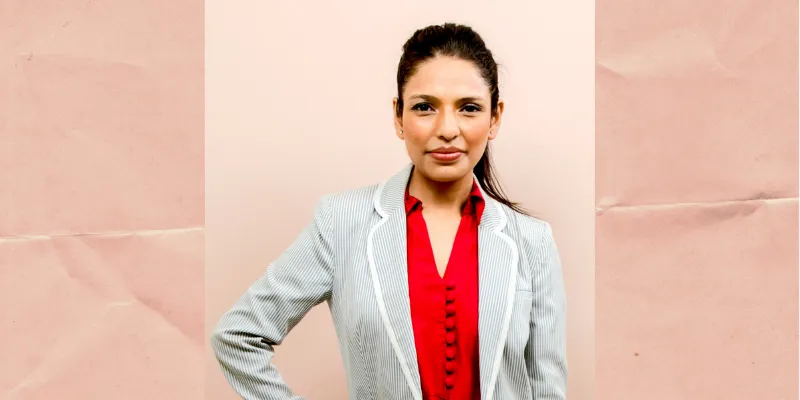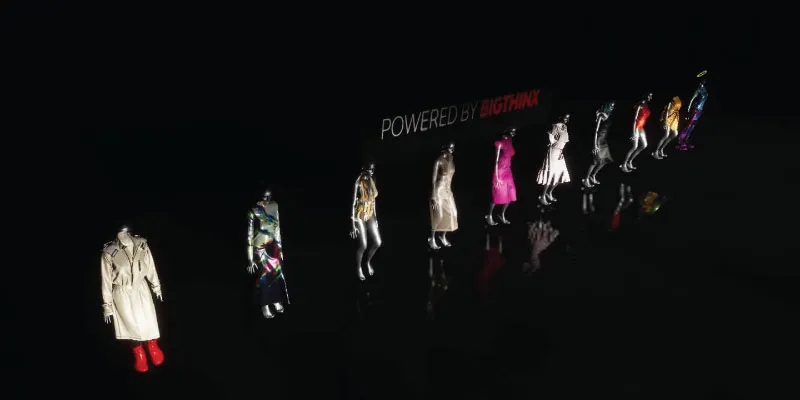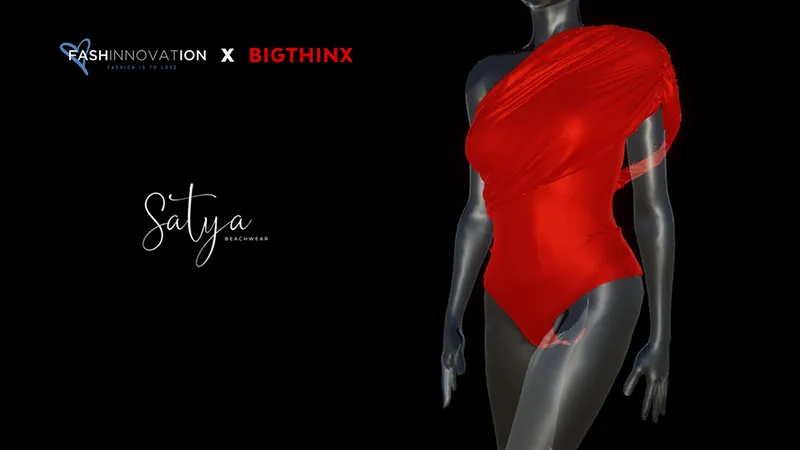Avatars on the catwalk: Bigthinx powers AI fashion show online
A virtual fashion show was held recently with digital avatars walking the ramp. This online event was conceptualised and created by Bengaluru based company, Bigthinx. Here's what the founders had to say about the fashion show...
The magnificent, fully digital 3D virtual livestreamed fashion show that took place on June 5 and June 8 and was handled by fashion tech company, .
The fashion show was like a dream-sequence coming to life. The lights dimmed and the soft strains of ’Floating Away’ sung by Alexia Bomtempo filled the air as the audience was taken to the banks of an ocean, where blue waters hugged the catwalk and beautiful motifs lit up the screens. Even as they gazed at the underwater fauna and the ever-present ocean with its rippling waves, it was difficult for most of them to believe that the models striding the catwalk were 3D virtual avatars and that they were watching an online fashion show that used automated AI based fashion digitalisation.

Shivang Desai
Co-founded by Shivang Desai and Chandralika Hazarika, Bengaluru-based Bigthinx is a deep-tech startup specialising in Artificial Intelligence for fashion, retail and fitness.
Shivang, who did his MBA (Finance & Strategy) at Case Western Reserve University, Ohio, USA, has already founded three startups, namely, one of the first drone manufacturers in India, a marketing and branding company for medical professionals (and an influencer marketing platform based on the stock markets. He is also a coder, technical artist and 3D modeller.

Chandralika Hazarika
Chandralika studied MBA (Marketing & HR) at IISWBM, Kolkata, India and worked at a Singapore based MNC for eight years as their brand head and helped them expand to various countries from Singapore, managing several diverse teams globally. In addition, she also owns her own fashion label, Velvet Piano.
In an exclusive interview with the Bigthinx founders, Shivang and Chandralika spoke about their fashion show and all that went into making it so special…
Edited excerpts from the interview:
YSW: How did the idea of a virtual fashion show come about?

A virtual fashion show by Bigthinx
Shivang Desai: In April 2020, a client who had been hard hit by the cancellation of fashion weeks and travel bans asked us if we could create a virtual photo shoot of their clothing on the avatar of a famous supermodel which they could showcase to their buyers and distributors around the world.
To illustrate the capabilities of Bigthinx’s technologies, we created a short demo video of the supermodel’s avatar walking a virtual ramp along with still captures which could be used in place of real photoshoots.
This video went viral and Fashinnovation reached out to Bigthinx and asked us to put on a virtual fashion show at their Worldwide Talks. We successfully delivered a virtual fashion show themed on “World Oceans Day” which featured clothing from 10 designers and brands from around the world, and virtual avatars of real models from HOP Models USA, and this was live streamed globally on 5th June, 2020.
YSW: Can you tell us about your company?
SD: Bigthinx is an AI company providing size, fit, and visualisation solutions for fashion and retail. Their LYFSIZE software uses just two smartphone pictures to determine 44 precise body measurements of any person, and uses a selfie of one’s face in addition to the body pictures to create a lifelike 3D virtual avatar that looks and measures exactly like the user.
E-commerce returns cost only the US economy $309 Billion in lost sales in 2019. This figure globally is worth trillions of dollars. 30%-50% of all apparel items bought online are returned which end up going to discount stores or are destroyed. Additionally, 84% of all clothing returns are destroyed through land-filling or incineration. This has a huge impact on the environment.
When we realised how big of a problem this was, we decided to build a product that could target it. As a fledgling company, we needed to take on the incumbents which were large corporations so we chose to use AI to differentiate our products and address certain inadequacies in the traditional way of doing business.
YSW: How did you envision the plan of digitising the human body?

A realistic 3D avatar
Chandralika Hazarika: As Bigthinx’s AI technology automatically creates lifelike virtual avatars and digital clothing, we requested pictures of the models which were created into virtual avatars, and detailed pictures of the clothing from the designers which were recreated in realistic 3D. These garments were showcased on the virtual avatars for the fashion show.
For fashion and retail, these pictures are taken through a smartphone app or mobile website which instantly create a virtual avatar of any user by generating 3D facial topography and virtual bodies sized to the measurements obtained. These avatars can be used for virtual clothing trials and also for gaming, fitness and a host of other applications.
YSW: How will this kind of show enable brands to personalise shopping and envision designs?
CH: This technology can not only simulate how clothing looks and drapes on digital versions of real people, but can also be sized up or down based on personal preferences to allow shoppers to choose the best look and fit for themselves.
This technology can evolve to being a standard part of e-commerce shopping experiences, branch out to in-store applications to allow quick and easy clothing trials, and be used to own purely digital collections for use in virtual communications and interactions.
With the coming of holograms in the near future, phygital interactions will also become commonplace. Moreover, the advantages of this technology lie in improving the entire supply chain of the fashion industry.
Human body data can be used by brands to tweak their clothing specifications and sizes to fit their shoppers better, produce only sizes that they know will sell and thus reduce wastage, and pre-trial designs with customers so that they manufacture only the products which have received positive responses.
YSW: Why did you choose World Environment Day to launch the fashion show? How did you plan the theme and the concept?

The shows supported environmental issues as they were held on World Environment Day and World Ocean's Day
SD: As June 8th was World Oceans Day, to show support for sustainability and solidarity with environmental issues, the founders of FASHINNOVATION - Jordana and Marcelo Guimaraes - had envisioned a theme of the ocean. Their concept resonated with us and we produced a show, supported by their creative artists with video and audio content, based on the ocean.
This entire show was produced in only two weeks without direct access to the designers, high resolution photos of fabrics and swatches, and proper model pictures. If we were to receive these details as requested, the realism and look would be far more lifelike. As fashion shows are aspirational events, complete justice needs to be done to the designs showcased.
YSW: How exact are the 3D virtual avatars from their 2D images and how did you go about doing this?

The avatars are produced to look exactly like human beings
CH: To digitise models, we request just a single front facing, evenly lit picture of the model’s face and two pictures of their full body, one each from the front and side. Bigthinx’s technology extracts 44 precise body measurements to recreate the virtual avatar and generated a topographical map of the person’s head to give their exact looks and measurements.
The avatars that are produced look exactly like digital versions of the real people. These avatars are similar to video game characters and can be used with our digital clothing just the same way that clothing is worn in real life. They are then animated to walk, pose and behave like real people as well. Therefore, they can be made to walk a virtual runway show and even pose for virtual photoshoots.
For e-commerce, these avatars can be seen live on any brand’s website, showcasing how their clothing looks and drapes on the shopper. For in-store shopping, customers can instantly set up and see their avatars dressed in the brand’s collections via screens mounted in the stores.
YSW: Why are fashion companies looking to automate their production processes? How will this kind of show help them?
SD: Fashion companies have traditionally been slow to adopt digital technology. However, with the COVID-19 pandemic, they have been forced to re-think their approaches to customer experience as well as designing, manufacturing, and supply chain management.
There is a huge scope for improvement in the way fashion companies operate such as using body data to improve clothing specifications to fit their shoppers better, identifying how many pieces of each size to manufacture to prevent wastage and unsold merchandise, digitally sample clothing designs pre-production, and even trial designs using virtual avatars of real customers to get a better idea of which products will sell better.
Virtual fashion shows are a quick and inexpensive way for such fashion companies to showcase their designers to audiences around the world.
YSW: How do you work with e-commerce brands, fashion rental companies; bespoke clothing companies, uniform or work-wear across the world?
CH: Our Lyfsize technology which uses mobile 3D body scans to determine a full range of body measurements are used by e-commerce brands to match their shoppers to their ideal clothing size in the brand, or in different collections within the same brand. It also provides fit information so that shoppers can decide which garment will fit them best.
Bespoke companies can use the full range of measurements, receiving the information from shoppers digitally without an in-person visit to take measurements.
For fashion rentals, where many times there is only one unique piece of each garment, body measurements allow the renters to determine which of the pieces available would fit them correctly. For P2P rentals, we compare the body measurements of the renter to the body types of the providers to find a size match across various body parts so that they can rent with confidence knowing that the clothing would fit them well.
For uniforms and workwear, we either determine the subject’s size instantly from their pictures, or provide a full set of measurements for tailored clothing. This process is easily carried out at the workplace, needing no training and only a smartphone, enabling size determination for thousands of workers in a single day without the need for logistics to organise trial pieces and teams for measurement-taking.
YSW: How would you work with Indian body types and sizes, which are very different from European sizes?
SD: Our technology works the same way irrespective of race and geographical location. It simulates clothing in the same way as real life, so different body types and sizes across the world are recreated regardless of their ethnicity. Therefore, we are equally well placed to work with Indian body types as with European ones.
YSW: What are the advantages of a virtual fashion show versus a real-time one? And what are the cons?
S&C: Real fashion shows allow in-person interactions and buyers to observe and sample clothing in the real world. However, they are extremely expensive undertakings and can definitely benefit from the use of digital technology.
We believe that even though digital fashion shows will not completely replace real ones, they will certainly become popular alternatives for brands that want to showcase numerous collections but don’t want to take on the burden and expense of real fashion shows. They will also become a levelling channel for e-commerce brands and upcoming designers who cannot afford to put on traditional fashion shows and can benefit from a digital medium.
This approach is far cheaper and much more sustainable than traditional methods, and we expect to see widespread adoption in the near future.
YSW: How did you choose the avatars for these shows?

Digital avatars feature in virtual ramp shows
CH: For the fashion show we did for FASHINNOVATION, the models were provided by HOP Models USA. For other shows, we would prefer to use the services of existing model agencies or even Instagram influencers who would like to lend their digital avatars to virtual ramp shows.
YSW: Which fashion designers were featured in these fashion shows and how were they chosen?
SD: The fashion designers featured were chosen by FASHINNOVATION for their diversity and commitment to sustainability.
The brands from all around the world included SAUIPE Swimwear, Artist Jason Naylor Jason Naylor Studio, NIKI by Niki Srinivasa, Olistic The Label, DiFiore New York, AWAYTOMARS, Satya Beachwear, SHOHEI, Jennifer Ritz and Helen Couture.
YSW: What was the response to the fashion show?
CH: The FASHINNOVATION event was a resounding success and our fashion show has received rave reviews from around the world.
YSW: What were some of the salient points that the fashion talks came up with that will be useful to fashion retail and fashionistas?
S&C: The main theme of the fashion talks this year revolved around sustainability and how the fashion industry, which is the second largest polluting industry in the world, can transition to more sustainable practices. Social impact was another big theme which stressed on providing more opportunities to the communities that sustain the industry.
YSW: Do you see these as your show as the future of fashion? How will you develop it further in the years to come?
SD: We see this fashion show as just one step among many towards creating the future of fashion.
Our technology can evolve to being a default part of e-commerce shopping experiences, branch out to in-store applications to allow quick and easy clothing trials, and be used to own purely digital collections for use in virtual communications and interactions. With the coming of holograms in the near future, physical interactions will also become commonplace.
Moreover, the advantages of our technology lie in improving the entire supply chain of the fashion industry. Human body data can be used by brands to tweak their clothing specifications and sizes to fit their shoppers better, produce only sizes that they know will sell and thus reduce wastage, and pre-trial designs with customers so that they manufacture only the products which have received positive responses.
Together with many other improvements using Industry 4.0, these will help to contribute towards the future of fashion.









